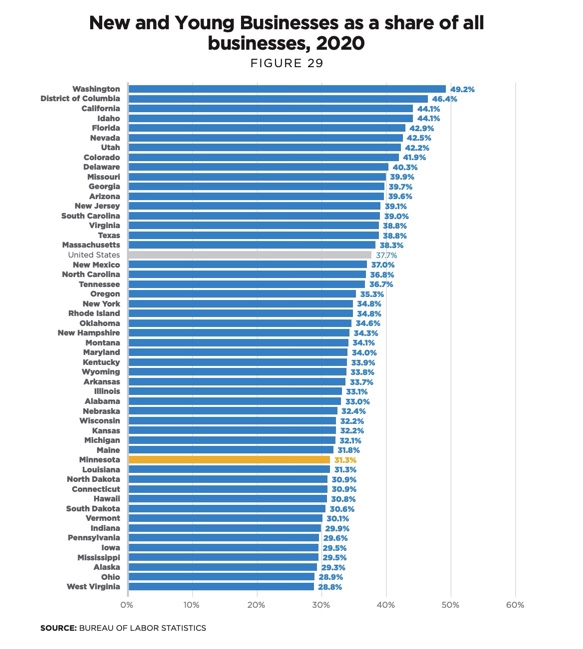Regulatory sandboxes could help improve entrepreneurship in Minnesota
In 2019, Minnesota ranked 49th among the states and D.C. for its rate of entrepreneurship per capita. In fact, in the last 20 years or so, Minnesota has only exceeded the national entrepreneurship rate four times. It is no secret that Minnesota does not perform well when it comes to entrepreneurship.
In 2020, Business creation (i.e., new and young businesses as a share of all businesses) in the state ranked among the bottom 15 states and was well below the national average. Moreover, between 2000 and 2020, business creation has gone down 4.6 percentage points, higher than the national average’s 4.2 percentage points decline. Employment in new and young businesses has also been shrinking in Minnesota at a higher rate compared to most states and the national average.

This is a very concerning trend. Research shows that new and young businesses are usually the major contributors to new job creation. While big and existing firms are usually job losers and creators, new businesses are only job creators. In addition to that, new businesses are also innovators, and they contribute to increasing competition in the market.
Leaving that aside, the lockdown-induced recession has wreaked havoc on Minnesota’s economy. This makes it all the more necessary that the state improves its entrepreneurial prospects. Entrepreneurship plays a big role in recovery by getting a lot of people to work and bringing economic levels back to normal. A lot of things, however, stand in the way of entrepreneurship in Minnesota, one being regulation.
Regulation stands in the way of entrepreneurship
Apart from high taxation, a lot of other things stand in the way of Minnesota improving its entrepreneurial landscape, one of them being regulation. Minimum wage laws, for example, have been found to be disproportionately harmful to small businesses, which includes start-ups.
Start-ups tend to pay lower and have lower profit margins, therefore increasing the minimum wage raises costs and making it more likely for those businesses to shut down. A 2019 study, for example, found that, among other things, increasing the minimum wage was associated with lower business entry and higher exit rates for small businesses.
In the same way, other regulations like occupational licensing act as a barrier to entry in low-income, low-risk occupations. While there is very little evidence that occupational licensing improves quality, a lot of empirical evidence exists detailing how such requirements reduce labor supply and raise prices by imposing unnecessarily high costs on individuals. Research evidence has found that states that require licenses for a lot of low-income occupations also end to have lower rates of low-income entrepreneurship
Graded on numerous measures that affect entrepreneurship, Minnesota does not rank very well. In fact, a 2020 Cato analysis ranked Minnesota as the 39th least burdensome state for entrepreneurship. A lot of other studies have ranked Minnesota quite unfavorably on regulation, for example, Arizona State’s Doing Business in North America Index.
Regulatory sandboxes can help
One significant reform that other states are undertaking that could help spur entrepreneurship and innovation is regulatory sandboxes. Currently, a number of states have enacted some form of industry-specific or universal –– e.g., Utah –– regulatory sandbox.
What are regulatory sandboxes? According to the Libertas Insitute, an organization that has been a principal driver in reforming Utah’s regulatory landscape,
A regulatory sandbox is a unique legal classification that creates space for regulators to temporarily freeze regulations and penalties. The process allows for private companies to develop or introduce an innovative product or service into a market space where current industry standards do not apply or are still being created.
Sandboxes are especially crucial in industries where innovation happens at a quick pace and regulations fail to keep up with changes, for example, the technology sector. When companies like Uber were created, regulation in the taxi industry was mostly fitting only for the traditional taxi model.
Uber’s model in many cities clashed with “decades-old taxi laws” which required, among other things, driver licensing, training and sometimes fingerprinting. Uber has been able to survive by pushing for the revision of outdated laws that impose stringent restrictions on such companies with similar platforms.
How sandboxes operate
When a state implements a regulatory sandbox, it is usually for a finite period of time. For example, Utah’s legal regulatory sandbox was initially supposed to run for two years, but has just been extended to seven. This means entrepreneurs in the legal industry can apply to develop and test out new goods or services in the industry as part of the sandbox program and be exempt from most pre-emptive regulations or penalties in those seven years without requiring licensing.
In 2022, regulators in Utah will assess whether innovations have been harmful or beneficial to consumers and the economy and also work to tailor/update regulations to fit the model of the new products as they transition to becoming fully licensed businesses.
This means that if every state had a regulatory sandbox when Uber was created, the company wouldn’t have had to go to such lengths to stay in business. Instead, such innovative ideas as digital ride-hailing services would have been allowed to operate and then be judged on its merit — whether it benefited or harmed consumers. Uber would have also not been forced to adhere to old rules; instead, lawmakers would have had to tailor regulations specifically to Uber’s model, while in the same process, getting rid of outdated laws.
Minnesota would benefit from regulatory sandboxes
Our economy has emerged out of the coronavirus pandemic changed. We have already seen increased rates of digitalization in the economy, which might only continue going forward. Enacting regulatory sandboxes in Minnesota would not only help improve entrepreneurship, but would also increase the development of new and innovative goods and services more fitting to the changing economic landscape.